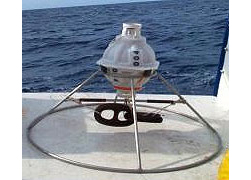Tutorial: Measure Temperature
The speed of sound in water depends on the water properties of temperature, salinity and pressure (directly related to the depth). A typical speed of sound in water near the ocean surface is about 1520 meters per second. That is more than 4 times faster than the speed of sound in air. The speed of sound in water increases with increasing water temperature, increasing salinity and increasing depth. Most of the change in sound speed in the surface ocean is due to changes in temperature. This is because the effect of salinity on sound speed is small and salinity changes in the open ocean are small. Near shore and in estuaries, where the salinity varies greatly, salinity can have a more significant effect on the speed of sound in water. As the depth increases, the pressure of the water has the largest effect on the speed of sound.
Under most conditions the speed of sound in water is simple to understand. Sound will travel faster in warmer water and slower in colder water. To measure the temperature of the water, a sound pulse is sent out from an underwater sound source and heard by a hydrophone in the water some distance away (up to thousands of kilometers). The time the sound takes to go from the source of the sound to the listening device (a hydrophone) is measured. From the travel time, the speed of sound between the source and the hydrophone can be calculated. If the salinity and depth where the sound traveled are known, the temperature of the water can be calculated. Two specific methods of measuring the temperature of the ocean with sound are explained below.

Acoustic Tomography uses precise measurements of acoustic travel times to draw ocean temperature maps, showing ocean temperatures just as weather maps show temperatures in the atmosphere. Data from many crossing acoustic paths are used to generate these maps of ocean temperatures. In the figure above, for example, four acoustic sources (S) are shown transmitting to five acoustic receivers (R), giving 20 acoustic paths through a region roughly 300 kilometers on a side. (This geometry was actually used in an experiment conducted in 1981.) Suppose that the shaded region is warmer than its surroundings. Sound that travels through the warm region will travel slightly faster than sound that does not, because sound speed increases with increasing temperature, as described above. The travel times of sound pulses traveling through the warm region will therefore be slightly shorter than they would have been if the warm region was not there. By combining all of the different travel times it is possible to draw a map showing the warm and cold regions through which the sound has traveled. This is important because the ocean has “weather” just as the atmosphere does. Warm and cold “eddies” that are the oceanic equivalent of atmospheric storms move around, grow, and weaken. There are subsurface oceanic cold and warm fronts just as there are cold and warm fronts in the atmosphere. These eddies and subsurface fronts have important effects on marine life, with marine animals that prefer warm water tending to remain in warm eddies, for example.
Inverted Echo Sounders (IES) measure the temperature of the water column at a single point. The IES is attached to the ocean bottom. It emits a sound pulse aimed toward the surface of the ocean. The sound pulse will reflect off the surface of the ocean and return to the bottom. The IES listens for the return of the sound pulse from the ocean surface. The travel time of the sound is used to calculate the speed of sound through the water. The temperature profile is calculated from the speed of sound through the water. The IES must be calibrated with a measurement of the water column properties. Sometimes a pressure sensor is used with the IES to make the calibration.
Inverted echo sounders are often used to monitor a particular region of the ocean. They are often placed in groups (or arrays) to cover a wider area.


Inverted echo sounder. Photo courtesy of Dr. Randy Watts, URI/GSO